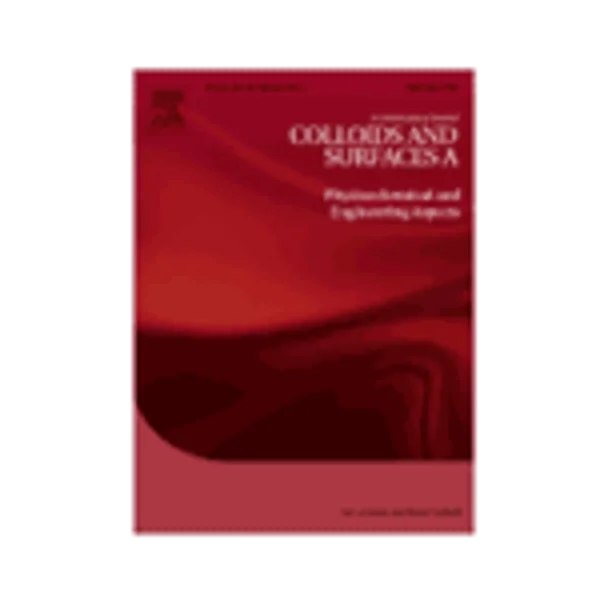-
electrokinetic potential of polystyrene particles in polyelectrolyte and polyelectrolyte mixtures solutions
جزئیات بیشتر مقاله- تاریخ ارائه: 1392/07/24
- تاریخ انتشار در تی پی بین: 1392/07/24
- تعداد بازدید: 1009
- تعداد پرسش و پاسخ ها: 0
- شماره تماس دبیرخانه رویداد: -
the effect of three samples of snf fo grade cationic polyelectrolyte (pe) and two samples of snf an grade anionic polyelectrolyte as well as their binary mixtures on the electrokinetic potential of monodisperse carboxylated polystyrene (ps) particles as a function of the contact time of polymer solution with particles, the polyelectrolyte/mixture dose, its composition, the charge density (cd) of polymers and sequence of their adding to the suspension has been studied. also the effect of ph and kcl concentration on the ζ-potential of “bare” and polymer-covered ps particles have been measured. it has been shown that addition of increasing amount of anionic polyelectrolytes increases the absolute value of the negative zeta-potential of ps particles; this increase is stronger the charge density of the polyelectrolyte and ph of the system are higher. adsorption of cationic polyelectrolytes leads to a significant decrease in the negative ζ-potential and to overcharging the particles; changes in the ζ-potential are more pronounced for pe samples with higher cd and for suspensions with lower ph values. in mixtures of cationic and anionic pe, in a wide range of mixtures composition, the ζ-potential of particles is determined by the adsorbed amount of the anionic polymer independently of the cd of polyelectrolytes and the sequence of addition of the mixture components. the isoelectric point of the surface is reached at the adsorbed amount of positive charges that is approximately equal to the surface charge density of particles. the laws observed were explained by features of macromolecules conformation in adsorbed mixed polyelectrolyte layers. considerations about the role of coulombic and non-coulombic forces in the mechanism of anionic/cationic polyelectrolyte adsorption are presented.
مقالات جدیدترین رویدادها
-
استفاده از تحلیل اهمیت-عملکرد در ارائه الگوی مدیریت خلاقیت سازمانی و ارائه راهکار جهت بهبود
-
بررسی تاثیر ارزش وجوه نقد مازاد بر ساختار سرمایه شرکت های پذیرفته شده در بورس اوراق بهادار تهران
-
بررسی تأثیر سطح افشای ریسک بر قرارداد بدهی شرکت های پذیرفته شده در بورس اوراق بهادار تهران
-
بررسی تأثیر رتبه بندی اعتباری مبتنی بر مدل امتیاز بازار نوظهور بر نقد شوندگی سهام با تأکید بر خصوصی سازی شرکت ها
-
تأثیر آمیخته بازاریابی پوشاک ایرانی بر تصویر ذهنی مشتری پوشاک ایرانی (هاکوپیان)
-
بررسی اثر ph روی حذف یون نیترات از آب توسط نانوفیلتراسیون
-
نقش سیستم نیتریک اکساید در تاثیر کورتیکوسترون بر اضطراب در موش کوچک آزمایشگاهی
-
مدیریت منابع آب سطحی با استفاده از سازه های پخش و کنترل سیلاب (مطالعه موردی حوضه آبریز هارکله لالی در استان خوزستان)
-
an alternative to kinematic hardening in classical plasticity
-
damping earthquake and wind energy in tall building by frictional semi-active dampers
مقالات جدیدترین ژورنال ها
-
مدیریت و بررسی افسردگی دانش آموزان دختر مقطع متوسطه دوم در دروان کرونا در شهرستان دزفول
-
مدیریت و بررسی خرد سیاسی در اندیشه ی فردوسی در ادب ایران
-
واکاوی و مدیریت توصیفی قلمدان(جاکلیدی)ضریح در موزه آستان قدس رضوی
-
بررسی تاثیر خلاقیت، دانش و انگیزه کارکنان بر پیشنهادات نوآورانه کارکنان ( مورد مطالعه: هتل های 3 و 4 ستاره استان کرمان)
-
بررسی تاثیر کیفیت سیستم های اطلاعاتی بر تصمیم گیری موفق در شرکتهای تولیدی استان اصفهان (مورد مطالعه: مدیران شرکتهای تولیدی استان اصفهان)
-
بررسی عوامل مؤثر بر مشارکت شهروندان در اداره ی امور شهری نمونه موردی: شهر همدان
-
بررسی رابطه بین معاملات بلوکه شده و همزمانی قیمت سهام
-
بررسی وضعیت خستگی در افراد مبتلا به دیابت نوع دو مراجعه کننده به مرکز تحقیقات غدد و متابولیسم اصفهان
-
تفسیر تطبیقی آیه انذار از منظر علّامه طباطبایی و ابن تیمیّه
-
تبیین الگوی وفاداری به مقصد گردشگران ورزشی در ایران




سوال خود را در مورد این مقاله مطرح نمایید :